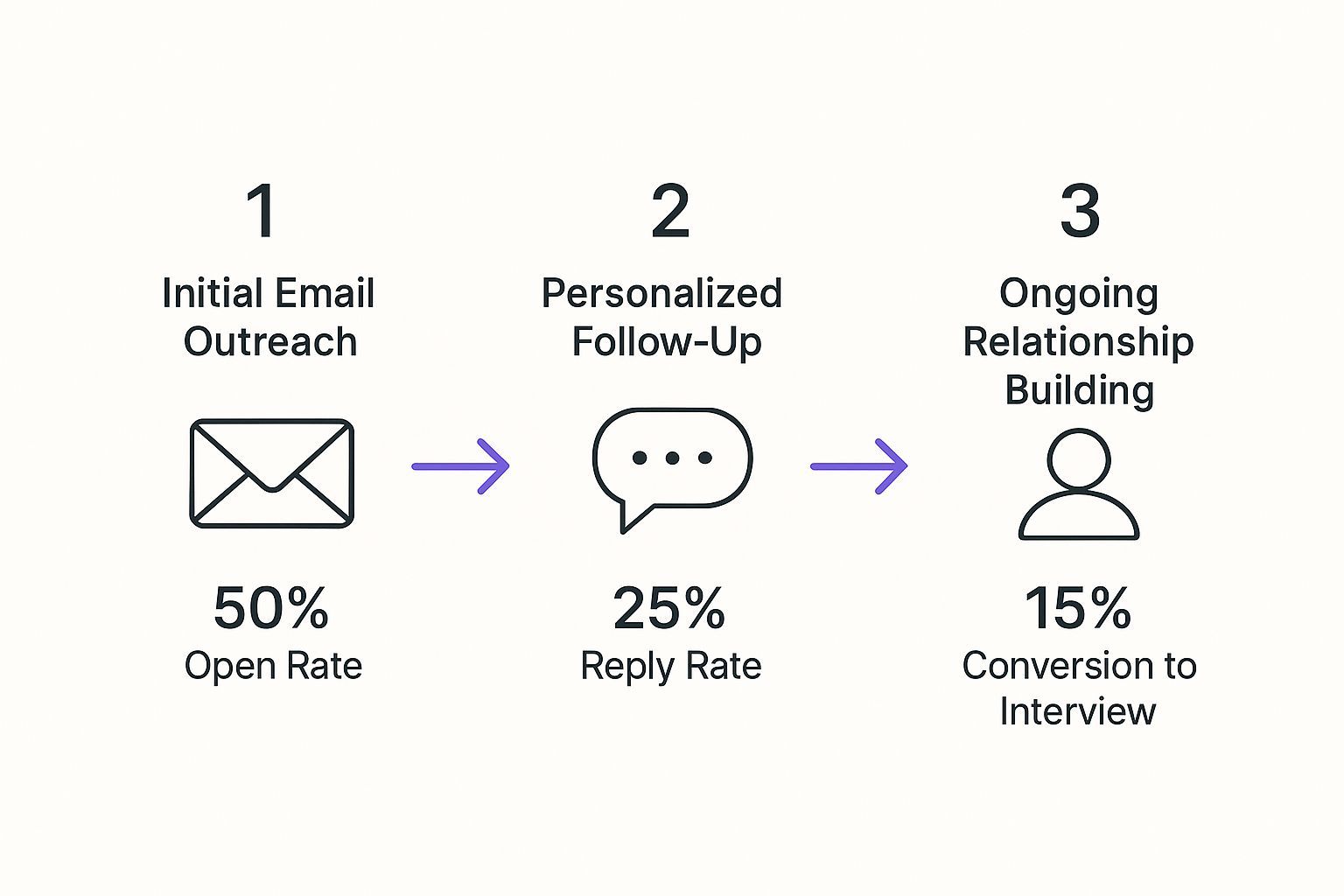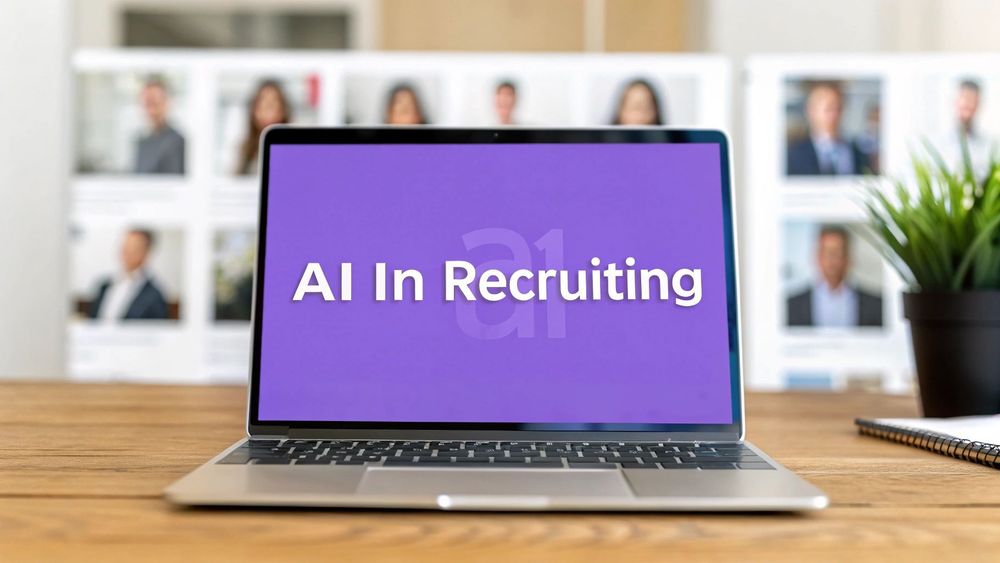To build a real talent pipeline, you have to completely change your mindset. Forget everything you know about traditional recruiting. It's time to shift from a reactive, fire-fighting model to a proactive, continuous strategy of sourcing, engaging, and nurturing potential candidates long before you actually need to fill a role.
This isn't about just collecting resumes. It's about creating a living, breathing database of talent, building genuine relationships over time, and making sure you always have qualified, interested people ready to go for future opportunities.
Why Proactive Recruiting Is a Business Imperative
Waiting around for the perfect candidate to magically apply to your job posting is a strategy that belongs in the past. It just doesn't work anymore.
In today's cutthroat market, the best talent is almost always passive—they’re happily employed and not scrolling through job boards. Reactive hiring, the old-school practice of starting a search only after a role opens up, puts your company at a huge disadvantage. It leads to a frantic scramble, rushed decisions, costly hiring mistakes, and frustrating project delays.
The real cost of an empty talent pipeline isn't just the time it takes to fill a seat. It's the lost productivity, the burnout on your existing team, and the missed business opportunities that slip away while you're busy searching. Building a talent pipeline is the strategic antidote to this all-too-common problem.

The Strategic Shift to Continuous Engagement
Proactive recruiting completely reframes hiring. It stops being a one-off transaction and becomes a continuous cycle of relationship-building. It means your talent acquisition team is always sourcing, always connecting, and always nurturing potential future hires. This is a game-changer for a few key reasons:
- Access to Passive Talent: You suddenly unlock a much larger pool of candidates, including top performers who aren't actively looking but would be open to the right opportunity if it came from someone they trust.
- Faster Hiring Cycles: When a position does open up, you're not starting from scratch. You already have a pre-vetted list of warm candidates, which can slash your time-to-hire from weeks or months down to just days.
- Improved Quality of Hire: Because you're not rushing, you have more time to evaluate skills and build real rapport. This leads to more informed decisions and ensures you find people who are a great fit for both the role and your company culture.
- A Serious Competitive Advantage: While your competitors are just hitting "post" on their job ad, you're already in final-round interviews with high-caliber candidates you've been talking to for months.
Reactive vs Proactive Recruiting At a Glance
Let's break down the real-world differences between the old way and the modern approach. It’s not just about speed; it's about strategic impact and long-term cost savings.
| Metric | Reactive Hiring (The Old Way) | Proactive Pipelining (The Modern Way) |
|---|---|---|
| Candidate Pool | Limited to active job seekers, often smaller and less diverse. | Vast, includes passive candidates, top performers, and diverse talent. |
| Time-to-Hire | Weeks or even months. High urgency leads to rushed processes. | Days or a few weeks. Pre-vetted candidates shorten the cycle. |
| Cost-per-Hire | High. Includes premium job board fees, agency costs, and overtime. | Lower. Reduced reliance on expensive sourcing channels. |
| Quality of Hire | Often compromised due to time pressure and a limited talent pool. | Consistently high. More time for assessment and culture fit. |
| Business Impact | Disruptive. Causes project delays and team burnout. | Seamless. Ensures business continuity and forward momentum. |
The table makes it pretty clear: reactive recruiting is a costly gamble. A proactive pipeline, on the other hand, is a strategic investment that pays dividends in talent quality, team stability, and overall business agility.
Future-Proofing Your Workforce
Adopting this strategic approach is becoming more urgent by the day. By 2025, global labor markets are set to face a massive shift driven by automation and evolving skill demands. This makes building a talent pipeline a non-negotiable strategic necessity.
The World Economic Forum's Future of Jobs Report 2025 paints a stark picture: they project the displacement of 85 million jobs worldwide due to automation, but also the creation of 97 million new roles that require entirely new skill sets.
The message here couldn't be clearer: the skills your company needs to thrive are changing at a breakneck pace. A proactive pipeline is the only way you can ensure you have access to the right talent to navigate this evolution without getting left behind.
To truly master this, you need to stay on top of current talent acquisition best practices. This is no longer just an HR function; it's a core business strategy that directly fuels your company's ability to innovate, grow, and outmaneuver the competition.
Mapping Your Future Hiring Needs
A solid talent pipeline isn't about filling the roles you have open today. It's about knowing who you'll need to hire tomorrow. This is a huge mental shift for a lot of recruiters—moving away from reactive hiring and tired, static job descriptions. Instead, you're creating a clear, forward-looking blueprint of your company's future talent.
You have to start thinking like a business strategist, not just a recruiter. The real goal here is to anticipate needs long before they turn into critical vacancies. This proactive approach keeps your sourcing efforts targeted and aligned with the company's long-term vision. It's the difference between a strategic hire and a last-minute scramble that often leads to a bad fit.

From Job Descriptions to Ideal Candidate Personas
Let's be honest: traditional job descriptions are usually just a laundry list of qualifications. They rarely capture the essence of what makes someone a top performer in a role. This is where the Ideal Candidate Persona (ICP) comes in. It’s a much more effective tool.
Think of an ICP as a semi-fictional profile representing the perfect hire for a future role. It goes way beyond just skills on a resume.
You're essentially creating a character sketch that should detail things like:
- Core Competencies: What are the absolute non-negotiable skills? This includes hard skills like "Proficient in Python," but also the crucial soft skills, like "Excels at cross-functional communication."
- Experience Level & Trajectory: Where are they in their career right now, and what’s their next logical step?
- Motivations & Drivers: What gets them out of bed in the morning? Are they driven by a desire to innovate, a need for stability, or a passion for making an impact?
- Cultural Fit: What personality traits and work styles will actually thrive on your team?
Building out these personas forces a much deeper conversation about what success in a role truly looks like. It’s far more insightful than a simple checklist.
Collaborating to Forecast Future Roles
Building an accurate talent map isn't a solo mission for the HR department. You absolutely have to get in the trenches with department heads and company leadership. Your job is to understand their strategic goals and translate them into future hiring needs.
Get regular check-ins on the calendar with your key stakeholders. Talk about their plans for the next 6, 12, and even 18 months. Ask probing questions to get ahead of potential talent gaps before they become five-alarm fires.
A killer question I love to ask is: "If you could hire three people right now to guarantee you hit your goals next year, what roles would they fill and what would make them exceptional?" This reframes the entire conversation from plugging holes to enabling future success.
This kind of collaborative forecasting helps you pinpoint not just what roles are coming, but which ones are historically a nightmare to fill. These "high-priority" roles need to be the immediate focus of your pipeline-building. For example, if you know from experience that finding great Senior Data Scientists is always a challenge, you should be building relationships with them now—even if the headcount isn't approved for another year.
This is the kind of forward-thinking that elevates a recruiting function from a support service to a strategic business partner.
Identifying Your High-Priority Roles
Once you have a rough map of the future, it’s time to prioritize. Not all roles are created equal, either in their impact on the business or in how hard they are to fill.
Use a simple framework to sort through your forecasted needs. For each potential role, ask yourself:
- Business Criticality: How essential is this role to hitting our core business objectives?
- Difficulty to Fill: Based on market data and past searches, how tough is it to find qualified people for this?
- Lead Time: How long does it typically take to hire for this position from the first outreach to their first day?
The roles that score high across all three categories are your top-priority targets. These are the positions where an empty seat costs the company the most in lost revenue or delayed projects. By focusing your initial pipeline efforts here, you'll deliver the most immediate and visible value to the business, proving the ROI of your proactive strategy right out of the gate.
Building Your Candidate Database The Smart Way
Alright, you've mapped out your future hiring needs. Now for the real work: finding and organizing the people who will fill those roles. This is where you actually start building your talent pipeline, and it's all about finding those incredible passive candidates—the top performers who aren't even looking for a new job. That requires a smart sourcing strategy and the right tools to keep all that information straight.
The old-school approach here is a total grind. We've all been there, spending hours crafting labyrinthine Boolean search strings on LinkedIn, painstakingly clicking through profiles, and then manually copy-pasting names, titles, and contact info into a spreadsheet. It’s tedious, error-prone, and eats up your most valuable resource: time.

The Old Way: Manual Sourcing and Soul-Crushing Data Entry
Picture this: you need to build a list of 50 Senior Software Engineers with experience in a niche programming language. The manual way is a massive time sink.
First, you'd burn hours just tweaking your search queries on LinkedIn or GitHub. Then, for every promising profile, you're stuck copying their name, company, location, and any contact info you can find. A task like this could easily eat up a few days of solid work. By the end, you're left with a static spreadsheet that starts going stale the second you save it.
This manual method isn't just inefficient; it's a bottleneck that keeps you from doing what really matters: engaging with candidates and building relationships. Every hour spent on admin is an hour you're not spending on strategic outreach.
The Modern Alternative: One-Click Data Extraction with ProfileSpider
Now, let's replay that scenario with a smarter workflow. You run the exact same search for Senior Software Engineers. But instead of the copy-paste marathon, you use a no-code profile scraper. With a single click, a tool like ProfileSpider instantly pulls all the relevant data from the entire search results page.
In just a few minutes, you have a perfectly structured list of 50 high-quality candidates, complete with names, job titles, and professional links. This data can be dropped right into a CSV, Excel file, or your CRM, ready for your engagement campaigns. You can see how ProfileSpider is built from the ground up to make this exact workflow feel effortless for non-technical users. It’s the modern, one-click alternative to traditional scraping.
Scaling Your Sourcing Efforts
The pressure to source efficiently is only getting more intense. A whopping 74% of businesses globally are reporting trouble finding talent and are now expanding their pipelines across borders, a trend supercharged by the rise of remote work. It’s no surprise that the demand for skilled talent acquisition specialists has jumped by 87% in the last year alone.
Automating the data collection piece of the puzzle is no longer a "nice-to-have"—it's essential for keeping pace. It lets you:
- Build Targeted Lists, Fast: Create segmented lists for different roles (think "Java Developers in NYC" or "Marketing Managers in LA") in a fraction of the time it used to take.
- Enrich Your Data: Go beyond just a name and title. Modern tools can grab social media links from platforms like LinkedIn, Facebook, and GitHub, helping you craft truly personal outreach.
- Maintain Data Integrity: Drastically cut down on the human error that comes with manual entry, ensuring your database is accurate and reliable.
To really get this right, you can adapt proven LinkedIn lead generation strategies for identifying and attracting top talent. The core principles are the same. By ditching manual methods for a smart, automated workflow, you free yourself up to focus on the human side of recruiting—building genuine connections that turn passive candidates into your next great hire.
Nurturing Relationships with Potential Hires
You’ve built a fantastic database of potential candidates using a smart, no-code tool like ProfileSpider. Awesome. But let’s be real for a second: a list of names, no matter how well-sourced, is not a talent pipeline. It’s just a list.
The real magic happens when you turn that raw data into a community of engaged professionals who know, respect, and actually want to work for your company. This is the nurturing phase, and it’s what separates a good recruiter from a great one.
Forget about generic, impersonal email blasts. The goal here is to build genuine rapport and establish your company as an employer of choice. It's all about delivering value, consistently, so when a role finally opens up, you aren't a stranger reaching out cold. You're the first person they think of.

Segment Your Talent Pool for Personalization
First things first: stop treating everyone in your pipeline the same way. A one-size-fits-all communication strategy just doesn’t cut it anymore. By segmenting your talent pool, you can deliver more relevant, personalized content that actually resonates with each group.
Think about breaking down your list based on a few key criteria:
- Role Type: You wouldn't talk to a software engineer the same way you'd talk to a marketing manager. Their interests, career paths, and motivations are worlds apart. Group them accordingly.
- Seniority Level: The content that grabs a junior developer's attention will be very different from what a VP of Engineering wants to see. Tailor your message to their experience.
- Geographic Location: This is a no-brainer for location-specific roles, but it's also great if you're hosting local networking events or meetups.
- Engagement Level: Keep an eye on who is actively engaging with your content—opening emails, clicking links, etc. These "warm" leads might be ready for a more direct conversation sooner than others.
Segmentation is how you move from mass messaging to meaningful conversations. It shows candidates you see them as individuals, not just another name on a spreadsheet.
Deliver Value-Driven Content
Okay, you’ve got your segments. Now, what do you actually send them? The key is to provide value, not just ask for something. Your goal is to become a trusted resource and keep your company top-of-mind. This means shifting your mindset from "recruiting" to "educating and engaging."
Here’s a little secret from the other side of the table: 70% of employees say that job-related training and development opportunities influenced their decision to stay at their job. When you share valuable content, you're showing them your company’s commitment to growth before they even apply.
Here are some practical content ideas to get you started:
- Insightful Industry Articles: Share thought-provoking pieces about trends in their specific field. This positions you as someone who is knowledgeable and plugged-in.
- Behind-the-Scenes Company Culture: Give them a glimpse of what it’s really like to work at your company. Post about team outings, employee spotlights, or volunteer days. Show the human side.
- Career Development Resources: Offer freebies like webinar recordings, ebooks, or guides that can help them get ahead in their careers. It’s a pure value-add.
- Company News and Milestones: Keep them in the loop about exciting company achievements, new product launches, or major awards. Let them be a part of the journey.
The content you share should be genuinely helpful and interesting, not just a sales pitch. If you want to get more advanced with this, you can even borrow some tactics from the pros and explore strategies used by marketing teams for audience research.
Build a Simple Content Calendar
Consistency is everything when you're nurturing relationships. Sporadic, random emails won’t build any momentum. A simple content calendar is all you need to plan your outreach and ensure you maintain a steady, non-intrusive presence.
You don't need some complex project management tool. A basic spreadsheet will do the trick. The idea is to map out what kind of content you're sending and when, based on how "warm" the candidate is.
This little table is a great starting point for thinking about your content strategy.
Talent Nurturing Content Ideas
| Engagement Stage | Content Type | Example |
|---|---|---|
| Initial Contact (New) | Value-First Introduction | "Hi [Name], I saw your work on [Project] and was impressed. Thought you'd find this article on [Industry Trend] interesting." |
| Awareness (Warm) | Company Culture Showcase | A monthly newsletter with an employee spotlight, a link to a recent company blog post, and a "day in the life" video. |
| Consideration (Hot) | Targeted Opportunity | "We're expanding our [Team] and a role is opening up that aligns perfectly with your experience in [Skill]. Would you be open to a brief chat?" |
A structured approach like this ensures you’re sending the right message at the right time. It transforms your pipeline from a static database into a dynamic ecosystem of potential hires, ready and willing to engage when the perfect opportunity comes along.
Integrating Technology to Scale Your Efforts
When your talent pipeline grows from a handful of great contacts into a sprawling community, spreadsheets and sticky notes just won't cut it. Trying to track everyone manually becomes an impossible task, and that’s where things start to fall apart. To really scale your pipeline and keep it healthy, you have to build a smart, integrated tech stack. This is the moment you graduate from manual grunt work to automated efficiency.
The right tech does more than just hold names and numbers; it gives you the power to manage relationships at scale. It takes over the administrative busywork, freeing you up to focus on what actually moves the needle: strategic outreach, personalized conversations, and building real connections with top-tier talent. Without a solid tech foundation, even the most carefully sourced pipeline will eventually become an overwhelming, unusable mess.
Choosing Your Core Recruiting Systems
At the center of any modern recruiting operation, you'll find two powerhouse platforms: an Applicant Tracking System (ATS) and a Candidate Relationship Management (CRM) system. They might sound similar, but they play very different—and equally important—roles in managing your talent flow.
- Applicant Tracking System (ATS): Think of this as your system of record for active job applicants. It’s built to manage the straight-line hiring process, from the moment someone applies to the day they get an offer. It keeps everything organized and compliant for your open roles. It’s all about managing the "now."
- Candidate Relationship Management (CRM): This is your secret weapon for the long game. A CRM is where you house and nurture your pipeline of passive candidates, silver medalists, and future stars who aren’t tied to a specific job opening today. It’s your tool for managing the "future."
For a truly robust talent pipeline, you absolutely need both. The ATS handles the formal, structured application process, while the CRM lets you build a warm community of talent long before a job ever hits the boards.
The Critical Role of Data Automation
Here’s a hard truth: your ATS and CRM are only as good as the data inside them. Manually typing in every single profile you find is a massive time-suck and a surefire way to make mistakes. This is where modern data automation tools become the glue that connects your sourcing efforts to your core systems.
Imagine you've just found a killer list of 50 software engineering leads on LinkedIn. The old-school way means blocking off your afternoon for painstaking data entry to get them into your CRM. The modern, no-code approach is a completely different story.
With a one-click tool like ProfileSpider, you can scrape all 50 profiles in a couple of minutes. The tool automatically pulls out names, titles, contact info, and professional links, organizing it all into a clean, structured format. You can then export that data as a CSV and upload it directly into your CRM or ATS, populating your pipeline in the time it takes to grab a coffee.
This kind of seamless integration completely changes your workflow. It blows up the administrative bottleneck, keeps your data clean, and lets you spend your time actually talking to candidates instead of fighting with spreadsheets. This is how you build and scale a talent pipeline without burning out.
Using AI and Analytics to Refine Your Pipeline
But technology's role goes way beyond just moving data around. The integration of artificial intelligence is making recruiters sharper at identifying and assessing talent. For instance, AI-powered candidate assessments can speed up hiring cycles by a whopping 46%, giving you data-driven insights that help you fine-tune your pipeline. It’s a shift the whole industry is feeling—85% of HR professionals now agree that data analytics is becoming essential in recruitment, pushing us all toward more evidence-based strategies. You can dig deeper into these hiring and recruiting statistics to see the trends for yourself.
This data-first approach helps you make smarter calls about where to invest your energy. By analyzing the metrics in your CRM, you can quickly see which sourcing channels bring in the best candidates or which outreach messages get the most replies. Technology gives you the visibility to constantly improve your pipeline's health and performance, making sure your hard work consistently leads to incredible hires.
Measuring Pipeline Health and Driving Improvement
So you've built a talent pipeline. Great. But the work doesn't stop there—in fact, it's just getting started. A pipeline isn't a trophy you put on a shelf; it's a living, breathing asset that needs regular check-ups to make sure it’s actually doing its job.
If you aren't measuring its performance, you're just hoarding contacts and hoping for the best. Tracking the right data is what separates a strategic talent community from a messy contact list. It’s how you move from guessing to knowing, allowing you to fine-tune your approach and prove the real-world value of your work.
Key Metrics to Track
To get a real sense of your pipeline's health, you don’t need a hundred different data points. Just focus on the handful of KPIs that truly tell the story of your efforts.
- Pipeline Conversion Rate: What percentage of candidates are actually moving from one stage to the next? Think sourcing to engagement, or engagement to interview. If people are dropping off, this metric will tell you where your nurturing efforts are falling flat.
- Time-to-Hire from Pipeline: This one is gold. Track how much faster you fill a role with someone from your pipeline compared to a cold applicant. This is your direct proof of ROI—a hard number that shows the value of proactive recruiting.
- Quality of Hire from Pipeline: This is the big one. Are your pipeline hires actually good? A simple 90-day performance review survey sent to hiring managers will give you the answer. High scores here mean you’re not just filling seats; you're finding top-tier talent that sticks.
- Source of Quality Hires: Where are your best people coming from? By tracking this, you’ll quickly see which channels are worth doubling down on and which ones are just noise.
Keeping Your Talent Pool Fresh and Engaged
A stale pipeline is a useless pipeline. The market is always moving, candidates take new jobs, and skills become outdated. Just look at the latest Talent Market Index report from May 2025—it shows employers are getting more selective, with application rates dropping from 5.6 to 4.8 per job, year-over-year. You can dig into the specifics in the global hiring trends report on hireborderless.com. This shift means having a current, engaged pool of talent is more critical than ever.
Treat your pipeline like a garden, not a warehouse. It needs consistent attention to thrive. Regularly prune outdated contacts and nurture promising prospects to ensure you're ready to harvest top talent when the need arises.
To keep things healthy, you need a rhythm of continuous improvement. Set aside time each quarter to clean up your data—get rid of unresponsive contacts and update profiles with the latest info. Even more important, run periodic re-engagement campaigns. A quick, personalized check-in with your most promising dormant candidates can be all it takes to reignite their interest and keep your company on their radar.
Your Top Talent Pipeline Questions, Answered
Jumping into talent pipelining is a big strategic move, so it's only natural to have a few questions. Let's walk through some of the most common ones I hear from recruiters who are just getting started.
How Long Does It Take to Actually Build an Effective Pipeline?
Look, there's no magic switch. To get a foundational pipeline up and running for a handful of your most critical roles, you're probably looking at about three to six months. That's the time it takes to really nail down your ideal candidate personas, source that first wave of talent, and get your engagement and nurturing workflows in place.
But here's the thing: a truly great pipeline is never "finished." It's more like a living, breathing part of your business that grows and changes right along with your hiring needs. The trick is to start small. Focus on the roles that cause the most pain when they're empty, and show some quick wins.
What's the Single Biggest Mistake I Should Avoid?
Easy. Treating your pipeline like a dusty, old database instead of a vibrant community.
It’s tempting to just scrape a bunch of names and profiles and call it a day, but that’s completely worthless if you don't follow up with real, human engagement.
The biggest pitfall is the "collect and forget" mentality. A pipeline without consistent, value-driven nurturing isn't a pipeline at all—it's just a list. And that list will be stale and useless before you know it. The goal is to build relationships, not just collect records.
How Can I Justify This Investment to My Boss?
You need to speak their language. Forget recruiter-speak and focus on the business case. Frame your pitch around cold, hard cost savings and reducing strategic risk. It's not a "nice-to-have"; it's a smart financial move.
Here's how you can break it down for them:
- Calculate the Cost of an Empty Seat: Do the math. Show them exactly how much productivity—and even revenue—is bleeding out the door for every single day a key position sits vacant.
- Show Them the Money Saved on Agency Fees: Pull up your agency spend from last year. A proactive pipeline directly slashes your reliance on those expensive third-party recruiters.
- Talk About Quality of Hire: This is a big one. Explain that when you build relationships over time, you get better-vetted candidates who are a stronger fit. That means better team performance, higher retention, and a direct impact on the bottom line.
When you lay it out like that, it becomes clear that building a talent pipeline isn't just another expense. It's a high-return investment in the company's future.




